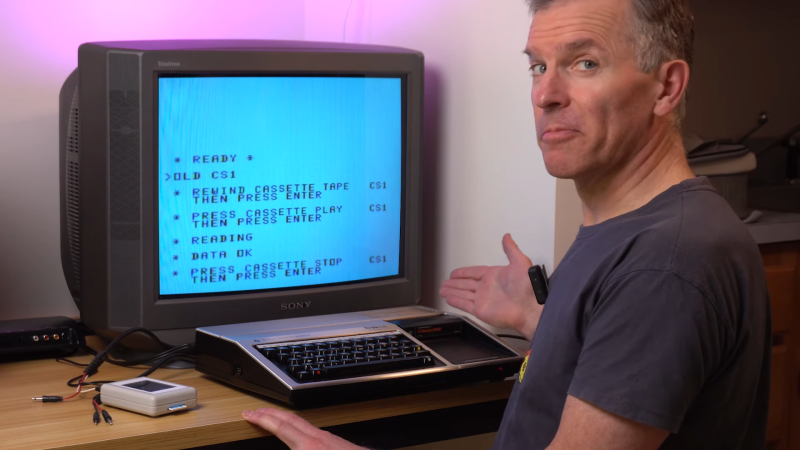In the three or four decades since storing programs on audio cassettes has been relevant, a lot of irreplaceable personal computing history has been lost to the ravages of time and the sub-optimal conditions in the attics and basements where tapes have been stored. Luckily, over that time we’ve developed a lot of tools and techniques that might make it possible to recover some of these ancient treasures. But as [Noel] shows us, recovering data from cassette tapes is a tricky business.
His case study for the video below is a tape from a TI-99/4A that won’t load. A quick look in Audacity at the audio waveform seems to show the problem — an area of severely attenuated signal. Unfortunately, no amount of boosting and filtering did the trick, so [Noel] had to dig a bit deeper. It turns out that the TI tape interface standard, with its redundant data structure, was somewhat to blame for the inability to read this particular tape. As [Noel] explains, each 64-bit data record is recorded to tape twice, along with a header and a checksum. If neither record decodes correctly, then tape playback just stops.
Luckily, someone who had already run into this problem spun up a Windows program to help. CS1er — our guess would be “Ceaser” — takes WAV file input and loads each record, simply flagging the bad ones instead of just bailing out. [Noel] used the program to analyze multiple recordings of the same data and eventually got enough good records to reassemble the original program, a game called Dogfight — or was it Gogfight? Either way, he managed to get most of the data off the tape, and since it was a BASIC program, it was pretty easy to figure out the missing bytes by inspection.
[Noel]’s experience will no doubt be music to the ears of the TI aficionados out there. Of which we’ve seen plenty, from the TI-99 demoscene to running Java on one, and whatever this magnificent thing is.















The running java on a TI link is a repeat of the previous link to the megademo.
This brings back memories, I had one of those.
The program is named after OLD CS1, the TI Basic command to load a file from tape (CaSsette 1).
Yeah, that old tape interface was a pain. I had the official TI cassette drive for my 99/4A, which was nothing more than a bog standard tape player that fed its audio into the computer and vice-versa. Bump the volume control or the tone control and all of the sudden none of your programs would load anymore.
Fun stuff. I did like the computer, though.
*wouldn’t load*
Sorry, forgot to proofread.
The Atari one had Atari’s proprietary connector on it and decoding circuitry in it. That sounds like a pain, but Atari’s peripherals (like the rest of their 8-bit platform) were ahead of its time. They were daisy-chainable and intelligent, like FireWire and Thunderbolt ones.
Other causes for trouble are related to the cassette drive itself.
Wobble, warble, wow and flutter.
Especially the cheap MC (compact cassette) is prone to them.
As for decoding.. It’s possible to make a digital image of a datasette.
It involves a Schmitt-Trigger or similar circuit.
Back in the 90s and 2000s, home computer enthusiasts had interfaced “digital” tape drives, like that of the C64, to parallel port (LPT port) of a PC.
The resulting image file was much cleaner than using a soundcard and a walkman.
Tip: If possible, use a battery-operated equipment.
If operated from mains, switching PSUs might cause noise and “stutter” on electro motors.
The noise also sneaks into the soundcard.
Anyone old enough to remember running a IMSAI8080 with a Don Tarbell cassette interface? I am. Talk about being finicky to load.
Not me, but my father, maybe. The interface is impressive I think.
But at the same time I do wonder what purpose it serves if there’s CP/M or MP/M. The software stored on cassette seems to be so limited in comparison to what the CP/M platform had to offer.
Tape had it’s uses.
For example way before the current metadata controversies, the NSA had people’s call records shipped to them on 9 track tapes. With someone involved at every local Bell the rumors were well established when I got started in database programming.
I quote the rumor: “The NSA has been maintaining the worlds largest database for years. They have a record of any phone number you have ever called and the number of times you’ve called it. Been getting regular tape shipments from all the bells. They know who all your connections are, especially the ones you try to hide. ‘They’ started doing this with index cards filled out by human operators.”
Tinfoil hat stuff for sure. You’d have to be a paranoid.
Floppy disks were expensive AF, tape cheap exchange media. IIRC a box of 10 low density floppies were about $30 in 1980 dollars. Call that two price doublings, so about $12 each in 2020 dollars. Still rarely used tape after floppy drive was acquired.
can i get the wav files